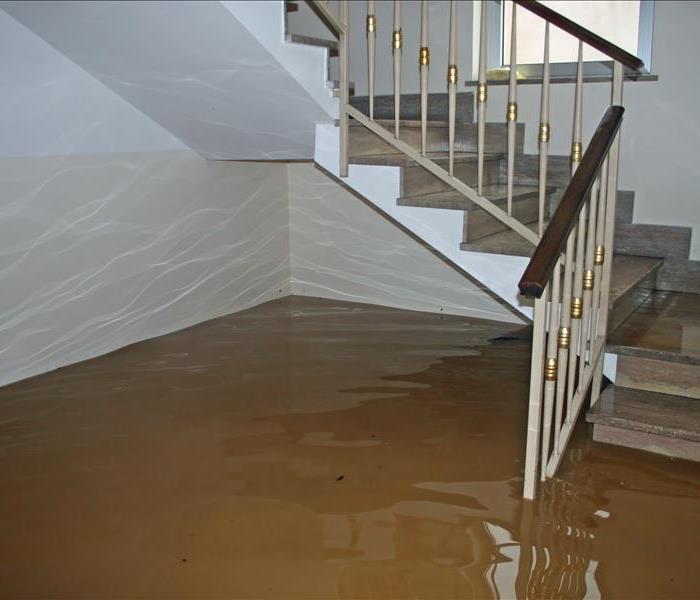How Challenging Is It To Complete Restoration After Flood Damage Affects My Randolph Home?
5/24/2020 (Permalink)
 If not taken care of properly, water damage can affect your home for much longer than you think. Contact SERVPRO right away.
If not taken care of properly, water damage can affect your home for much longer than you think. Contact SERVPRO right away.
The Training and Experience SERVPRO Crews Have Helps in Identifying and Dealing with Challenging Aspects of Flood Damage
Flooding incidents affect Randolph properties in many ways, including soiling and contaminating them. The sudden moisture influx from flooding also affects a variety of materials in the house ranging from fabrics, wood, and even composites. Some damages to materials are readily discernible, while others may remain hidden until you scrutinize an area thoroughly or extreme deterioration finally reveals the problem.
How do I know which materials are damaged?
Identifying the materials that flood damage affects at your Randolph home is an essential part of planning the restoration process. In addition to noting which items or materials are damaged, identifying the level of deterioration matters since it is what determines whether repairs can be done successfully or replacements are necessary. When you know the different ways flooding affects materials, it is easier to identify the damaged ones. The typical ways materials end up damaged include:
- Exposure to contamination
- Over saturation of materials
- Heavy soiling
The level of damage in Randolph caused by contamination depends on the physical traits of the affected material. Any porous materials affected by the groundwater are damaged beyond repair because even deep cleaning leaves some traces of the contaminants. The most common porous materials affected during flooding include:
- Floor materials such as carpets and pad
- Wall materials such as drywall and insulation
- Content fittings such as foam, sponge or cardboard
Absorption of significant amounts of water can change materials physically, compromise bonds holding materials together, or cause disintegration in other ways. For instance, wood swells, warps, buckles, or cups, depending on where it is installed. For carpets, the fibers separate from the backing, while drywall crumbles under the slightest pressure. Such problems are readily discernible so you can tell which materials are damaged.
How do I deal with the damaged materials?
You have various options when dealing with materials damaged during flooding incidents. For the non-porous and semi-porous materials, cleaning can help restore heavily soiled materials while drying helps reverse the effects of moisture. For effective cleaning, the use of chemicals to loosen or breakdown soils and disinfectants and other antimicrobial agents is necessary. Agitation and other physical cleaning actions are also necessary. For materials or contents damaged extensively, removal is the only solution. Our SERVPRO technicians also take other steps to safeguard the items, tools, and areas we clean, including:
- Separating the work area where necessary to prevent the spread of contaminants
- Creating a decontamination area by setting up a 6-mil plastic sheet on the floor, ceiling and continuous wall-wrap
- Setting up a contents cleaning area in an uncontaminated section of the property
- Setting a load out area next to the work area where we hold bagged waste awaiting removal to the disposal site.
Are there unexpected challenges that develop when resolving flood damage?
Proper planning and use of the correct equipment helps the process of restoring flood-damaged properties run smoothly. However, unexpected issues can arise at any point during the restoration. For instance, failure to observe safety precautions when using chemical products to clean, disinfect, or deodorize the property can lead to irritation or even injury. Our SERVPRO technicians follow manufacturer directions when mixing or applying such products. We also use protective equipment, including respirators, and splash goggles for safety.
Removal of moisture introduced by the floodwaters or cleaning processes is essential to restore the property to its preloss state. However, this is easier said than done. One unforeseen issue that can halt the drying process is moisture equilibrium, which happens when the moisture in a material is at par with the condition of the surrounding air. With this condition, moisture does not move from the wet materials to the air. Our crews increase the heat and air movements to break the equilibrium. We use air movers to boost air movements and portable heaters to increase temperature. Exhausting warm air from dehumidifiers back into the room also helps raise the temperature.
Stubborn odors can also develop in your property after a flooding incident. Odors can be real or imagined since the sight of your property heavily soiled can have a psychological effect that gives you the impression that there is a smell. Some odors might also emanate from cleaning agents, finishing products applied on surfaces, or the wetness. Such odors disappear naturally over time. Our SERVPRO technicians help remove the odors, or in case of temporary or imagined odors, we use masking agents that produce a sweet scent.
A flood-damaged property can present many challenges that delay restoration. Call SERVPRO of Southwest Morris County at (973) 895-5000 to manage any incident, "Like it never even happened."






 24/7 Emergency Service
24/7 Emergency Service